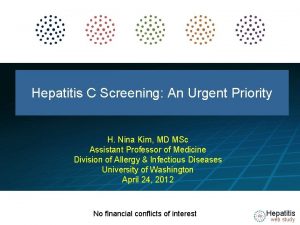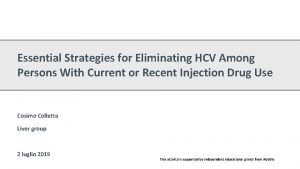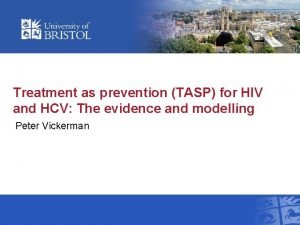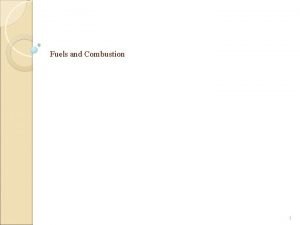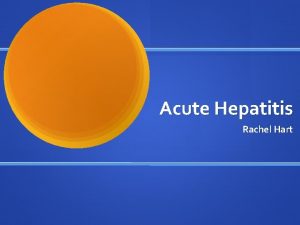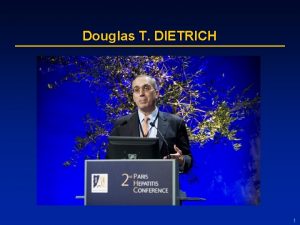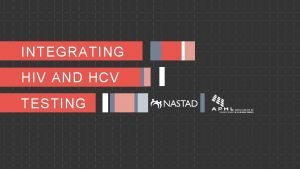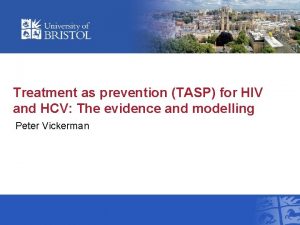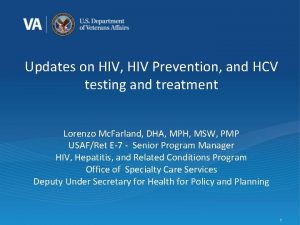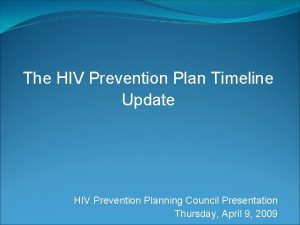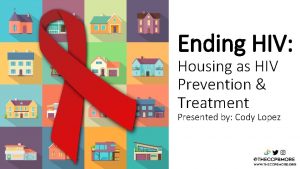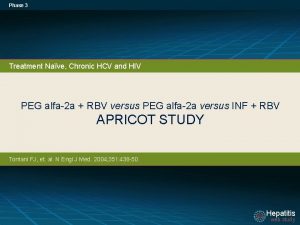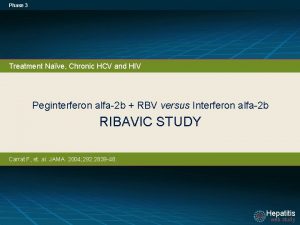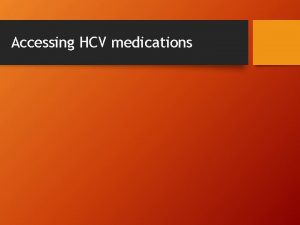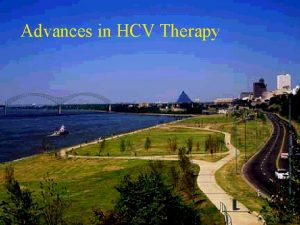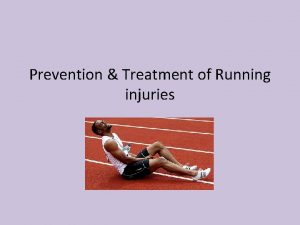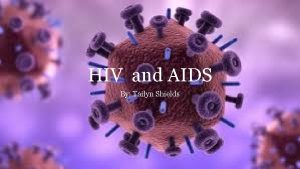Treatment as prevention TASP for HIV and HCV
















- Slides: 16

Treatment as prevention (TASP) for HIV and HCV: The evidence and modelling Peter Vickerman

HIV treatment as prevention • Discussion started in late 80 s/early 90 s, because treatment reduced viral load in plasma and semen • Ever since HIV treatment has been available, modelling has been used to argue whether it could decrease or increase transmission (Anderson Nature 1991 and others, Blower Science 2000) • Early cohort studies suggesting it may reduce transmission in sero-discordant couples (Musicco Arch Int med 1994) • Quinn NEJM 2000 was first to show viral load related to HIV infectivity

Hypothesis proven by HPTN 0052 (Cohen NEJM 2011) • Sero-discordant heterosexual couples • 96% reduction for linked HIV transmissions and 89% reduction for all transmissions

However, results vary • Some cohort studies have suggested lower effectiveness: • Pooled estimate gives 42% reduction • Is this due to bias or lower adherence in real life settings • All studies from sero-discordant couples – generalisable? Risk of HIV Transmission in Serodiscordant Couples Treated vs Untreated With Antiretroviral Therapy in Observational Studies. Source: Figure adapted with permission from Cochrane HIV/AIDS Group. (Anglemyer JAMA 2013)

Population impact amongst heterosexuals in real world setting • Two innovative cohort studies from Kwa Zulu Natal, South Africa 1. Is risk of HIV transmission related to coverage of ART in surrounding local community (Tanser Science 2013)? 2. Is risk of HIV transmission related to coverage of ART amongst opposite sex household members (Vandormael, Lancet Global Health 2014)? • Study 1 showed that 38% less likely to become HIV-infected if 30 -40% coverage of ART in community instead of <10% • Study 2 showed transmission risk reduced by 5 -6% for each 10% increase in ART coverage amongst HIV+ household members: • If 100% coverage then 45% reduction in incidence Tanser, Science 2013 Vandormael, Lancet Global Health 2014

Modelling impact of scaling up ART • Model projections from 12 models for South Africa • Broadly agree with Tanser • Impact of 80% ART access to all HIV +ves by 2020: • 50 -70% ↓ HIV incidence if 15% LTFU 3 years • 60 -80% ↓ if no LTFU Eaton Plos med 2012

HIV TASP IN HIGH RISK GROUPS - MSM AND PWID

Evidence of efficacy in MSM • Until recently, little data on effect of ART on MSM HIV transmission • New data from European PARTNER study found NO transmissions through condomless sex when HIV+ partner on ART and virally suppressed: • But only 330 years of follow up so far Rodger, A. et al. HIV transmission risk through condomless sex if the HIV positive partner is on suppressive ART: PARTNER study. CROI 2014

What about at population level for MSM – example of UK for 2001 to 2010 Improvements in cascade of care from 2001 to 2010 • 4 fold increase in frequency of HIV testing of MSM • Time to diagnosis decreased from 4 to 3. 2 years • Proportion diagnosed at CD 4>350 increased from 48% to 65% • ART coverage in diagnosed MSM rose from 69% to 80% BUT: • Estimated number undiagnosed has not changed at about 8000 • Number new HIV infections each year remained stable at ~2500 • Similar situation of increasing or stable HIV diagnoses in MSM populations in other western settings with high coverage of ART Birrell. Lancet 13: 313– 18 2013 Griensven curr op hiv aids: 4: 300 -307 2009 Muessig AIDS 2012

What does modelling suggest for UK If no ART % condomless sex HIV incidence • Modelling suggests that increases in condomless sex acts maintained HIV incidence with ART – agrees with increase in STI prevalence over period • Model projects much higher HIV incidence without ART • Undiagnosed cases contribute 82% of new HIV infections and mostly acute • To reduce HIV incidence need to reduce both undiagnosed fraction and provide ART at diagnosis Phillips, A. et al. Plos one 2013 Reduce % undiagnosed and ART at diagnosis

In People who inject drugs (PWID) • Although biologically plausible, NO direct evidence for efficacy or effectiveness • Some studies used ecological correlations between community measures of HIV viral load and HIV incidence to postulate that scaled -up ART has decreased HIV transmission amongst IDUs Wood BMJ 2009 for Vancouver; Kirk CROI 2011 for Baltimore

What has modelling shown? • If protective then ART is: • Likely to be effective and cost-effective • Impact limited by role of HIV acute phase • Unlikely to reduce HIV transmission to low levels unless combined with other interventions Strathdee Lancet 2010, Degenhardt Lancet 2010, Kato JAIDS 2013, Alistar Plos Med 2011

TASP FOR HCV IN PWID

HCV treatment as prevention for PWID • • Highly effective curative treatment exists No evidence that treatment can reduce transmission at population level However, modelling suggests could have strong impact And could be more cost-effective than treating non-IDUs Zeiler DAD 2010, Vickerman DAD 2010, Martin J. Hepatology 2011, Martin Hepatology 2012

New DAA THERAPY COULD dramatically reduce HCV PREVALENCE over 15 YEARS , BUT… Treatment rates required to halve chronic prevalence within 15 years: Edinburgh: 15/1000 PWID annually (2 -fold increase) Melbourne: 40/1000 PWID annually (13 -fold increase) Vancouver: 76/1000 PWID annually (15 -fold increase) If future treatments cost $50, 000 USD per course, halving prevalence within 15 years would require: • Edinburgh: $3. 2 million USD annually • Melbourne & Vancouver: ~$50 million USD annually Martin NK, Vickerman P, Grebely J, Hellard M, Hutchinson SJ, Lima VD, Foster GR, Dillon J, Goldberg DJ, Dore G, and Hickman M. HCV treatment for prevention among people who inject drugs: modeling treatment scale-up in the age of direct acting antivirals. Hepatology 2013

Summary • HIV treatment can be highly effective for reducing infection risk in serodiscordant couples and MSM: • Impact at population level is more uncertain although evidence emerging • However, in MSM HIV incidence has increased in many settings as ART has been scaled up massively • Evidence for impact in PWID is weak although biologically plausible, but if effective: • Could reduce HIV transmission dramatically, be cost-effective, but unlikely to lead to elimination • HCV treatment works, but no evidence that works as a prevention strategy, although biologically plausible • Modelling suggests could have large impact and be cost-effective, but • Evidence is needed at population level, costs need to be reduced and cascade of care needs improving to enable scale up
 Hcv treatment
Hcv treatment Hcv treatment
Hcv treatment Primary prevention secondary prevention tertiary prevention
Primary prevention secondary prevention tertiary prevention The total army sponsorship program
The total army sponsorship program What does tasp stand for
What does tasp stand for Stakeholders in hiv prevention
Stakeholders in hiv prevention Global hiv prevention coalition
Global hiv prevention coalition Otto hoffman's method
Otto hoffman's method Hep c symptoms female
Hep c symptoms female Douglas t dietrich
Douglas t dietrich Hcv window period
Hcv window period Chapter 25 sexually transmitted infections and hiv/aids
Chapter 25 sexually transmitted infections and hiv/aids Chapter 24 sexually transmitted diseases and hiv/aids
Chapter 24 sexually transmitted diseases and hiv/aids Fspos vägledning för kontinuitetshantering
Fspos vägledning för kontinuitetshantering Typiska drag för en novell
Typiska drag för en novell Tack för att ni lyssnade bild
Tack för att ni lyssnade bild Ekologiskt fotavtryck
Ekologiskt fotavtryck
